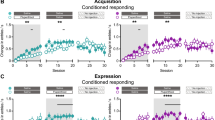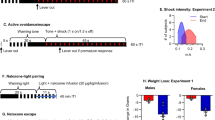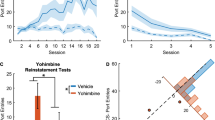Abstract
Rationale
Psychostimulant sensitization heightens behavioral and motivational responses to reward-associated stimuli; however, its effects on stimuli associated with reward absence are less understood.
Objectives
We examined whether amphetamine sensitization alters performance during Pavlovian–instrumental transfer (PIT) to conditioned excitors and inhibitors. We further sought to characterize the effects of amphetamine sensitization on learning versus performance by exposing rats to amphetamine prior to Pavlovian training or between training and test.
Methods
Adult male Long–Evans rats were given conditioned inhibition (A+/AX−) and Pavlovian (B+) training, followed by variable-interval instrumental conditioning. Rats were sensitized to d-amphetamine (2 mg/kg daily injections for 7 days) or served as non-exposed controls. Rats were given a PIT test, in which they were presented with stimulus B alone or in compound with the conditioned inhibitor (BX).
Results
During the PIT test, control rats significantly reduced instrumental responding on BX trials (to approximately 50 % of responding to B). Amphetamine sensitization prior to Pavlovian conditioning increased lever pressing on BX trials and reduced lever pressing on B trials compared to controls. Amphetamine sensitization between training and test increased lever pressing on B and BX trials compared to controls. No effects of sensitization were observed on conditioned food cup approach.
Conclusions
Amphetamine sensitization increases instrumental responding during PIT to a conditioned inhibitor by enhancing the excitation of conditioned stimuli and reducing the inhibition of conditioned inhibitors.







Similar content being viewed by others
References
Berridge KC (2009) ‘Liking’ and ‘wanting’ food rewards: brain substrates and roles in eating disorders. Physiol Behav 97:537–550
Berridge KC (2012) From prediction error to incentive salience: mesolimbic computation of reward motivation. Eur J Neurosci 35:1124–1143
Berridge KC, Robinson TE, Aldridge JW (2009) Dissecting components of reward: ‘liking’, ‘wanting’, and learning. Curr Opin Pharmacol 9:65–73
Blaiss CA, Janak PH (2007) Post-training, but not post-reactivation, administration of amphetamine and anisomycin modulates Pavlovian conditioned approach. Neurobiol Learn Mem 87:644–658
Bray S, Rangel A, Shimojo S, Balleine B, O’Doherty JP (2008) The neural mechanisms underlying the influence of Pavlovian cues on human decision making. J Neurosci 28:5861–5866
Childress AR, Listerud J, Franklin T, Langleben D, Kampman K, Monterosso J, Acton P, Gray J, Fornash A, O’Brien CP (2002) Imaging the substrates of cue-induced drug craving and its modulation by pharmacologic or behavioral interventions. Biol Psychiatry 51:157S
Colwill RM, Rescorla RA (1988) Associations between the discriminative stimulus and the reinforcer in instrumental learning. J Exp Psychol Anim Behav Process 14:155–164
Corbit LH, Janak PH, Balleine BW (2007) General and outcome-specific forms of Pavlovian–instrumental transfer: the effect of shifts in motivational state and inactivation of the ventral tegmental area. Eur J Neurosci 26:3141–3149
Delamater AR, Holland PC (2008) The influence of CS–US interval on several different indices of learning in appetitive conditioning. J Exp Psychol-Anim Behav Process 34:202–222
Delamater AR, LoLordo VM, Sosa W (2003) Outcome-specific conditioned inhibition in Pavlovian backward conditioning. Learn Behav 31:393–402
Dickinson A, Smith J, Mirenowicz J (2000) Dissociation of Pavlovian and instrumental incentive learning under dopamine antagonists. Behav Neurosci 114:468–483
Edgar D, Hall G, Pearce JM (1981) Enhancement of food-rewarded instrumental responding by an appetitive conditioned stimulus. Q J Exp Psych 33B:3–19
Ehrman RN, Robbins SJ, Childress AR, Obrien CP (1992) Conditioned-responses to cocaine-related stimuli in cocaine abuse patients. Psychopharmacology 107:523–529
Epstein DH, Marrone GF, Heishman SJ, Schmittner J, Preston KL (2010) Tobacco, cocaine, and heroin: craving and use during daily life. Addict Behav 35:318–324
Estes WK, Skinner BF (1941) Some quantitative properties of anxiety. J Exp Psychol 29:390–400
Everitt BJ, Wolf ME (2002) Psychomotor stimulant addiction: a neural systems perspective. J Neurosci 22:3312–3320
Flagel SB, Clark JJ, Robinson TE, Mayo L, Czuj A, Willuhn I, Akers CA, Clinton SM, Phillips PE, Akil H (2011) A selective role for dopamine in stimulus-reward learning. Nature 469:53–57
Hall DA, Gulley JM (2010) Disruptive effect of amphetamines on Pavlovian to instrumental transfer. Behav Brain Res 216:440–445
Harmer CJ, Phillips GD (1999) Enhanced conditioned inhibition following repeated pretreatment with d-amphetamine. Psychopharmacology 142:120–131
Holland P (2004) Relations between Pavlovian–instrumental transfer and reinforcer devaluation. J Exp Psychol- Anim Behav Proc 30:258–268
Hollander JA, Carelli RM (2007) Cocaine-associated stimuli increase cocaine seeking and activate accumbens core neurons after abstinence. J Neurosci 27:3535–3539
Holmes NM, Marchand AR, Coutureau E (2010) Pavlovian to instrumental transfer: a neurobehavioural perspective. Neurosci Biobehav Rev 34:1277–1295
Jentsch JD, Taylor JR (1999) Impulsivity resulting from frontostriatal dysfunction in drug abuse: implications for the control of behavior by reward-related stimuli. Psychopharmacologia 146:373–390
Kearns DN, Weiss SJ, Panlilio LV (2002) Conditioned suppression of behavior maintained by cocaine self-administration. Drug Alcohol Depend 65:253–261
Lex A, Hauber W (2008) Dopamine D1 and D2 receptors in the nucleus accumbens core and shell mediate Pavlovian–instrumental transfer. Learn Mem 15:483–491
Lombas AS, Kearns DN, Weiss SJ (2008) A comparison of the effects of discriminative and Pavlovian inhibitors and excitors on instrumental responding. Behav Process 78:53–63
Lovibond P (1981) Appetitive Pavlovian–instrumental interactions—effects of inter-stimulus interval and baseline reinforcement conditions. Q J Exp Psychol B-Comp Physiol Psychol 33:257–269
McClure SM, Daw ND, Read Montague P (2003) A computational substrate for incentive salience. Trends Neurosci 26:423–428
McDannald MA, Galarce EM (2011) Measuring Pavlovian fear with conditioned freezing and conditioned suppression reveals different roles for the basolateral amygdala. Brain Res 1374:82–89
Nadler N, Delgado MR, Delamater AR (2011) Pavlovian to instrumental transfer of control in a human learning task. Emotion 11:1112–1123
O’Brien CP, Childress AR, Ehrman R, Robbins SJ (1998) Conditioning factors in drug abuse: can they explain compulsion? J Psychopharmacol 12:15–22
Ostlund SB, Maidment NT (2012) Dopamine receptor blockade attenuates the general incentive motivational effects of noncontingently delivered rewards and reward-paired cues without affecting their ability to bias action selection. Neuropsychopharmacology 37:508–519
Rescorla RA (1969) Pavlovian conditioned inhibition. Psych Bull 72:77–94
Rescorla RA, Holland PC (1977) Associations in Pavlovian conditioned inhibition. Learn Motiv 8:429–447
Robinson TE, Berridge KC (1993) The neural basis of drug craving: an incentive-sensitization theory of addiction. Brain Res Brain Res Rev 18:247–291
Robinson TE, Flagel SB (2009) Dissociating the predictive and incentive motivational properties of reward-related cues through the study of individual differences. Biol Psychiatry 65:869–873
Saddoris MP, Stamatakis A, Carelli RM (2011) Neural correlates of Pavlovian-to-instrumental transfer in the nucleus accumbens shell are selectively potentiated following cocaine self-administration. Eur J Neurosci 33:2274–2287
Saunders BT, Robinson TE (2012) The role of dopamine in the accumbens core in the expression of Pavlovian-conditioned responses. Eur J Neurosci 36:2521–2532
Schiltz CA, Kelley AE, Landry CF (2005) Contextual cues associated with nicotine administration increase arc mRNA expression in corticolimbic areas of the rat brain. Eur J Neurosci 21:1703–1711
Shiflett MW (2012) The effects of amphetamine exposure on outcome-selective Pavlovian–instrumental transfer in rats. Psychopharmacology (Berl) 223:361–370
Simon N, Mendez I, Setlow B (2009) Effects of prior amphetamine exposure on approach strategy in appetitive Pavlovian conditioning in rats. Psychopharmacology 202:699–709
Smith KS, Berridge KC, Aldridge JW (2011) Disentangling pleasure from incentive salience and learning signals in brain reward circuitry. Proc Natl Acad Sci U S A 108:255–264
Talmi D, Seymour B, Dayan P, Dolan RJ (2008) Human Pavlovian–instrumental transfer. J Neurosci 28:360–368
Taylor JR, Jentsch JD (2001) Repeated intermittent administration of psychomotor stimulant drugs alters the acquisition of Pavlovian approach behavior in rats: differential effects of cocaine, d-amphetamine and 3,4-methylenedioxymethamphetamine (“ecstasy”). Biol Psychiatry 50:137–143
Tindell AJ, Berridge KC, Zhang J, Peciña S, Aldridge JW (2005) Ventral pallidal neurons code incentive motivation: amplification by mesolimbic sensitization and amphetamine. Eur J Neurosci 22:2617–2634
Tobler PN, Dickinson A, Schultz W (2003) Coding of predicted reward omission by dopamine neurons in a conditioned inhibition paradigm. J Neurosci 23:10402–10410
Vanderschuren L, Kalivas PW (2000) Alterations in dopaminergic and glutamatergic transmission in the induction and expression of behavioral sensitization: a critical review of preclinical studies. Psychopharmacology 151:99–120
Wan X, Peoples LL (2008) Amphetamine exposure enhances accumbal responses to reward-predictive stimuli in a Pavlovian conditioned approach task. J Neurosci 28:7501–7512
Wassum KM, Ostlund SB, Balleine BW, Maidment NT (2011) Differential dependence of Pavlovian incentive motivation and instrumental incentive learning processes on dopamine signaling. Learn Mem 18:475–483
Weiss SJ, Thomas DA, Weissman RD (1996) Combining operant-baseline-derived conditioned excitors and inhibitors from the same and different incentive classes: an investigation of appetitive-aversive interactions. Q J Exp Psychol B 49:357–381
Wyvell CL, Berridge KC (2001) Incentive sensitization by previous amphetamine exposure: increased cue-triggered “wanting” for sucrose reward. J Neurosci 21:7831–7840
Acknowledgments
This research was supported by grant 026559 from the National Institute on Drug Abuse. I would like to thank Joan Morrell and Julia Basso for assistance with collecting locomotor activity data. All experiments comply with current laws in the USA.
Conflict of interest
None.
Author information
Authors and Affiliations
Corresponding author
Rights and permissions
About this article
Cite this article
Shiflett, M.W., Riccie, M. & DiMatteo, R. The effects of amphetamine sensitization on conditioned inhibition during a Pavlovian–instrumental transfer task in rats. Psychopharmacology 230, 137–147 (2013). https://doi.org/10.1007/s00213-013-3144-3
Received:
Accepted:
Published:
Issue Date:
DOI: https://doi.org/10.1007/s00213-013-3144-3




